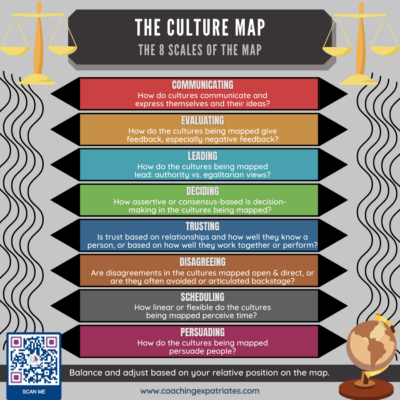
Bridging Cultures
“As globalization transforms the way we work, we now need the ability to decode cultural differences in order to work effectively with others.” Erin Meyer, Professor & Consultant
The unfortunate reality is that most people conducting international business have limited awareness of how culture influences their work. Without the ability to interpret other cultures and avoid common cultural pitfalls, we are vulnerable to misunderstandings, unnecessary conflicts, and potential failure. One of the most insightful guides to this complex terrain is Erin Meyer’s book, The Culture Map. My friend Loes thought I would like this book. And she was right. In this blog, I will explore the key lessons from The Culture Map and how they relate to the art of listening—an often underappreciated but critical skill in cross-cultural communication.
Understanding The Culture Map
Erin Meyer, a professor at INSEAD, developed The Culture Map as a tool to help individuals and organizations better navigate the complexities of international business. The book presents a framework for understanding cultural differences along eight dimensions:
- Communicating: Low-context vs. high-context communication.
- Evaluating: Direct negative feedback vs. indirect negative feedback.
- Persuading: Principles-first vs. applications-first reasoning.
- Leading: Egalitarian vs. hierarchical leadership.
- Deciding: Consensual vs. top-down decision-making.
- Trusting: Task-based vs. relationship-based trust.
- Disagreeing: Confrontational vs. avoidant disagreement styles.
- Scheduling: Linear-time vs. flexible-time orientation.
These dimensions offer a roadmap for understanding how people from different cultures approach communication, leadership, and collaboration. But beyond understanding these differences, The Culture Map emphasizes the importance of adapting our behavior to bridge these cultural gaps. This is where the art of listening comes into play.

Listening: The Bridge Across Cultures
Listening is a fundamental component of effective communication. Yet, in cross-cultural settings, it takes on an even greater significance. Listening goes beyond simply hearing words; it involves understanding context, reading between the lines, and interpreting what is not said as much as what is.
In low-context cultures, such as the United States or Germany and The Netherlands, communication is explicit, and the meaning is often found in the words themselves. However, in high-context cultures, such as Japan or India, much of the communication is implicit, relying on context, tone, and body language. Effective listening in these environments requires an awareness of these subtleties and an ability to pick up on cues that might be overlooked in a low-context setting.
Listening and the Eight Dimensions of Culture
Listening is a crucial skill when dealing with the nuances of cross-cultural communication. In a multicultural context, listening helps bridge the gap between different communication styles. For example, in a meeting with Japanese colleagues, where silence and pauses might be used to convey meaning, a listener would be attuned to these subtleties and understand that what is not said can be as important as what is verbalized.
Each of the eight dimensions in The Culture Map presents unique challenges that can be effectively navigated through listening.
- Communicating: In low-context cultures, listening involves focusing on the explicit content of the message. In high-context cultures, it requires an understanding of the broader context, including the relationship between the speakers and the unspoken elements of the conversation.
- Evaluating: Direct negative feedback can be jarring for individuals from cultures that prefer indirect feedback. Listening carefully to the tone, phrasing, and context in which feedback is given can help you respond appropriately and avoid misunderstandings.
- Persuading: Different cultures prioritize different methods of persuasion. Some may value logical reasoning (principles-first), while others may be more influenced by practical examples (applications-first). Listening to how arguments are presented can give insight into the best way to frame your own points.
- Leading: Egalitarian cultures encourage open dialogue, where leaders and subordinates communicate freely. In hierarchical cultures, however, listening involves paying attention to cues about status and authority, ensuring that you respect these dynamics in your interactions.
- Deciding: In consensual cultures, decisions are made through extensive discussion and agreement. Listening in this context involves being patient and open to different viewpoints. In top-down cultures, on the other hand, decisions may be made quickly by leaders, and listening helps you understand and adapt to these decisions without expecting extensive debate.
- Trusting: In relationship-based cultures, trust is built over time through personal connections. Listening plays a crucial role in understanding the subtleties of relationship dynamics and the importance placed on personal rapport. In task-based cultures, trust is more likely to be established through competence and reliability, which requires listening to understand expectations and deliver on them.
- Disagreeing: In confrontational cultures, disagreement is seen as a healthy part of dialogue, while in avoidant cultures, it’s often smoothed over. Listening helps you gauge when and how to express disagreement in a way that is culturally appropriate and productive.
- Scheduling: In linear-time cultures, punctuality and deadlines are critical. Listening to discussions about timelines can help you understand the importance of adhering to schedules. In flexible-time cultures, the emphasis might be more on relationships and the flow of events, so listening helps you navigate these more fluid timelines without causing offense.
Real-Life Applications: Listening in Action
Let’s consider a practical scenario: A team of global colleagues is working on a project, with members from the United States, France, and China. The American team members are direct in their communication and expect others to be the same. The French colleagues value debate and critique, seeing it as a path to the best ideas. Meanwhile, the Chinese team members might prefer a more harmonious and indirect approach, avoiding open conflict.
In this situation, listening is key to ensuring smooth collaboration. The American team members need to listen not just to what their French and Chinese colleagues say but also to how they say it. They might need to read between the lines of what the Chinese colleagues express and understand that silence or non-verbal cues are part of the communication. Conversely, the French team members should listen for the directness in the Americans’ communication and recognize that critique might not be received as constructively by the Chinese team.
By practicing listening, each team member can adapt their communication style to better align with their colleagues’ cultural preferences, thereby fostering a more inclusive and effective working environment.
Building Better Teams Through Listening
In today’s globalized workplace, teams are increasingly diverse, bringing together individuals from different cultural backgrounds. While this diversity can lead to richer ideas and perspectives, it can also lead to misunderstandings if cultural differences are not managed effectively. Listening is the cornerstone of building trust, resolving conflicts, and achieving team cohesion.
When team members listen to each other—truly listen—they are more likely to understand and appreciate the diverse perspectives each person brings to the table. This not only helps in avoiding conflicts but also in leveraging the full potential of the team’s diversity. Teams that master the art of listening are better equipped to innovate, solve problems, and succeed in a globalized market.
The Culture Map offers invaluable insights into the complex world of cross-cultural communication. However, understanding these insights is only the first step. To truly bridge cultural divides, we must also cultivate the art of listening – listening not just to words, but to context, subtext, and the cultural nuances that shape how we communicate.




